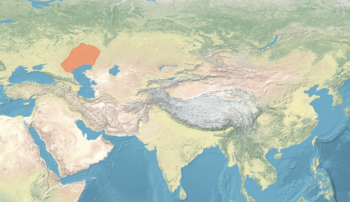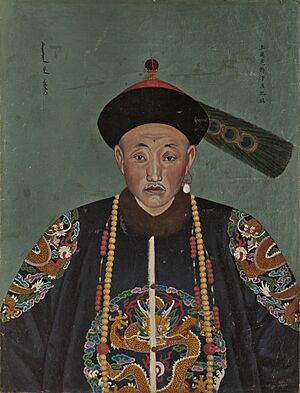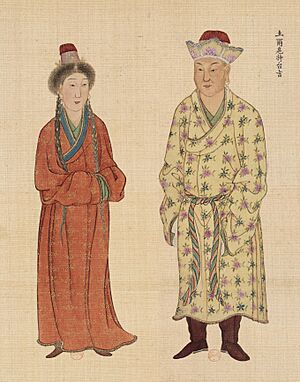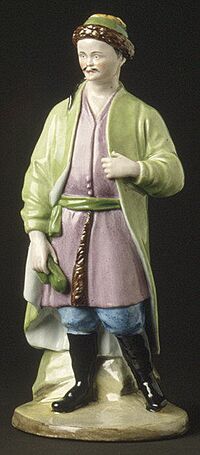Kalmyk Khanate facts for kids
Quick facts for kids
Kalmyk Khanate
Kalmyk: Хальмг хана улс
|
|||||||||||||
|---|---|---|---|---|---|---|---|---|---|---|---|---|---|
| 1630–1771 | |||||||||||||
|
Banner granted by Elizabeth of Russia to Donduk Dashi as a Khan of Kalmykia
|
|||||||||||||

Map of the Kalmyk Khanate
|
|||||||||||||
| Status | Khanate | ||||||||||||
| Capital | Ayuka Khan's residence (1697–1724) | ||||||||||||
| Common languages | Kalmyk, Russian | ||||||||||||
| Religion | Tibetan Buddhism (Gelug, Karma Kagyu) | ||||||||||||
| Government | Hereditary monarchy | ||||||||||||
|
• died 1644
|
Kho Orluk | ||||||||||||
|
• 1669–1724
|
Ayuka Khan | ||||||||||||
| History | |||||||||||||
|
• Established
|
1630 | ||||||||||||
|
• Annexed by Russia
|
1771 | ||||||||||||
|
|||||||||||||
The Kalmyk Khanate (also known as Xal'mg xana uls in Kalmyk) was a powerful kingdom of the Oirats (a group of Mongol people). It was located on the wide, flat grasslands of Eurasia, covering parts of what is now Kalmykia and nearby areas in the North Caucasus.
During its time as an independent state, the Kalmyks sometimes fought against Russia and sometimes became its allies. They often went on military trips against other groups like the Crimean Tatars, the Ottoman Empire, and other Muslim tribes. The Kalmyk Khanate became part of the Russian Empire in 1771.
Contents
History of the Kalmyk Khanate
Early Years and Self-Rule (1630–1724)
When the Oirats arrived in the lower Volga River region in 1630, they settled on land that used to belong to the Astrakhan Khanate. This land was then claimed by the Russian government. The area was not very populated, stretching from south of Saratov to Astrakhan. It covered both sides of the Volga River.
The Russian government was not ready to settle this area. They could not stop the Oirats from moving in. However, Russia wanted to make sure the Oirats did not team up with their Turkic-speaking neighbors.
The Oirats quickly made their position strong. They pushed out most of the people already living there, who were part of the Nogai Horde. Many Nogais moved southeast to the North Caucasian plain or west to the Black Sea steppe. These lands were claimed by the Crimean Khanate, which was connected to the Ottoman Turks. Smaller groups of Nogais sought protection from the Russian army in Astrakhan. The other nomadic tribes in the area became subjects of the Oirats.
At first, the relationship between the Russians and the Oirats was difficult. Both sides often raided each other's settlements. The Oirats raided Russian towns, and the Cossacks and Bashkirs (who were Muslim allies of Russia) raided Oirat camps. Many agreements were signed to ensure the Oirats' loyalty and military help. Even though the Oirats became subjects of the Russian Tsar, their loyalty was often just on paper.
The Oirats actually governed themselves using a document called the Great Code of the Nomads (Iki Tsaadzhin Bichig). This Code was created in 1640 by the Oirats and their relatives in Dzungaria and Eastern Mongolia. They met near the Tarbagatai Mountains to solve their problems and unite under the Gelugpa Buddhist group. Even though they did not fully unite, the leaders approved the Code, which set rules for all parts of nomadic life.
As the Oirats became stronger, they became an important power on the border. They often allied with the Russian government against their Muslim neighbors. During the time of Ayuka Khan, the Oirats became very strong politically and militarily. The Russian government often asked for Oirat cavalry (horse soldiers) to help in their wars. These wars were against Muslim powers in the south, such as Persia, the Ottoman Empire, the Nogays, and the Crimean Khanate.
Ayuka Khan also fought against the Kazakhs. He conquered the Mangyshlak Turkmens and led many trips against the mountain people of the North Caucasus. These military actions showed how important the Kalmyk Khanate was. It acted as a protective zone between Russia and the Muslim world, while Russia fought wars in Europe.
To get Oirat cavalry for their military campaigns, the Russian government gave money and goods to the Oirat Khan and nobles. In this way, Russia treated the Oirats much like they treated the Cossacks. However, giving money and goods did not stop the raids between them. Sometimes, both sides failed to keep their promises.
The Russian government also allowed the Oirats to trade freely in Russian border towns. The Oirats could trade their animals and goods from Asia for Russian products. They also traded with nearby Turkic tribes under Russian control, like the Tatars and Bashkirs. This trading was very good for the Oirat leaders.
This period, from 1630 to 1724, was a time of little change in the Kalmyk way of life. There was not much mixing between Kalmyks and Russians. They mainly traded goods like livestock for things nomads needed, such as brick tea, grain, and metal items. Political contact involved treaties where the Kalmyk Khans promised loyalty to Russia. A few Kalmyk nobles became more like Russians and even became Christian, hoping for Russian help. Over time, Kalmyk princes began to need Russian support and follow Russian policies.
During Ayuka Khan's rule, the Kalmyk Khanate was at its strongest. It had a good economy from free trade with Russian towns, Qing China, and Muslim neighbors. Ayuka Khan also stayed in touch with his Oirat relatives in Dzungaria and the Dalai Lama in Tibet.
Major Conflicts and Alliances
The Kalmyks were involved in many battles and alliances:
- 1603: Kalmyks attacked the Khanate of Khiva and parts of the Bukhara Khanate.
- 1607: They had a big fight with the Kazakh Khanate, but the Kazakh ruler Esim Sultan defeated them.
- 1619: To make up for their loss, the Kalmyks moved south and captured the Nogais.
- 1620: The Kalmyks attacked the Bashkirs.
- 1635: They fought against the Astrakhan Tatars in winter.
- 1645: The Kalmyks attacked Kabardia in the North Caucasus.
- 1658: They had a successful campaign against the Crimean Tatars and Nogais.
- 1666: Kalmyk troops helped the Russian government fight against the Tatars, Turks, and Polish in Ukraine.
- 1668: United Kalmyk and Cossacks forces joined a campaign against Crimea.
- 1676: Some Kalmyks fought in the Russian-Turkish war.
- 1696: The Kalmyks helped capture Azov.
- 1700: Kalmyks played an active role in the Great Northern War, including the Battle of Poltava.
- 1711: A large force of Kalmyks and Russians attacked Kuban. They captured many animals and people.
- 1735: The Kalmyks were involved in the Russian-Turkish War. They also had successful campaigns in Kuban and Crimea.
- 1756–1761: The Kalmyks took part in the Seven Years' War.
- 1812-1814: Kalmyks joined the Patriotic War against Napoleon. They received many awards and medals for their bravery, including for the capture of Paris.
From Oirat to Kalmyk Identity
Historically, the West Mongolian tribes called themselves by their tribal names. Around the 15th century, four main West Mongolian tribes formed an alliance. They called themselves "Dörbet Oirat". After this alliance ended, the West Mongolian tribes were simply called "Oirat." In the early 17th century, another large Oirat state appeared, called the Dzungar Khanate. While the Dzungars were building their empire, the Khoshuts created the Khoshut Khanate in Tibet. The Torghuts formed the Kalmyk Khanate in the lower Volga region.
After settling in the Volga region, the Oirats started to call themselves "Kalmyk." This name was supposedly given to them by their Muslim Kazakh neighbors. Later, the Russians used this name to describe them. The Oirats used this name when dealing with outsiders, like Russians and Muslims. But among themselves, they still used their tribal or clan names.
However, not all Oirat tribes in the lower Volga region immediately accepted the name Kalmyk. Even in 1761, the Khoshut and Dzungars (who were refugees from the Qing Empire) still called themselves and the Torghuts only "Oirats." The Torghuts, on the other hand, used the name Kalmyk for themselves and for the Khoshut and Dzungars.
Over time, the Oirat people who settled in the lower Volga region began to use the name Kalmyk. This was true no matter where they lived, such as in Astrakhan, the Don Cossack region, Orenburg, Stavropol, the Terek, and the Urals. Another common name for them was Ulan Zalata, meaning "the red buttoned ones."
Loss of Independence (1724–1771)
After Ayuka Khan died in 1724, the Kalmyk government became unstable. Different groups fought to become the next Khan. At the same time, the Russian government slowly took away the Kalmyk Khanate's independence. For example, Russia encouraged Russian and German people to settle on lands the Kalmyks used for their animals.
Also, the Russian government forced the Kalmyk Khan to have a council, which reduced his power. Yet, they still expected the Kalmyk Khan to provide cavalry units to fight for Russia. The Russian Orthodox Church also tried to get many Kalmyks to become Orthodox Christians. By the mid-17th century, the Kalmyks were unhappy with settlers moving onto their land and Russia interfering in their affairs.
In the winter of 1770–1771, Ubashi Khan, Ayuka Khan's great-grandson and the last Kalmyk Khan, decided to lead his people back to their original homeland, Dzungaria. This land was then controlled by the Qing dynasty. Ubashi Khan asked the Dalai Lama for his blessing and to set the departure date. The Dalai Lama chose a date based on astrology. However, when it was time to leave, the Volga River ice was too weak. This meant only the Kalmyks on the eastern bank could leave. Those on the western bank had to stay behind.
Under Ubashi Khan's leadership, about 200,000 Kalmyks began their journey from the Volga River to Dzungaria. About five-sixths of the Torghut tribe followed Ubashi Khan. Most of the Khoshuts, Choros, and Khoits also went with the Torghuts. However, the Dörbet tribe chose not to go. The Kalmyks who resettled in Qing territory became known as Torghuts.
Estimates say about 169,000 people left, along with millions of animals. They faced raids, thirst, cold, and hunger. Only about 70,000 survivors made it to Dzungaria.
After her forces failed to stop the flight, the Russian Empress Catherine II officially ended the Kalmyk Khanate in October 1771. She transferred all government power over the remaining Kalmyks to the governor of Astrakhan. The title of Khan was abolished. The highest native office left was the Vice-Khan, who was also recognized as the highest-ranking Kalmyk prince by the government. By appointing the Vice-Khan, the Russian government now had full control over Kalmyk affairs.
List of Kalmyk Khans

- Kho Orluk (1633–1644)
- Shukhur Daichin (1644–1661)
- Puntsug (Monchak) (1661–1672)
- Ayuka Khan (1672–1723)
- Tseren Donduk Khan (1723–1735)
- Donduk Ombo Khan (1735–1741)
- Donduk Dashi Khan (1741–1761)
- Ubashi Khan (1761–1771)
- Dodbi Khan (1771–1781)
- As Saray Khan (1781)
See also







